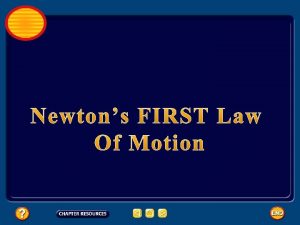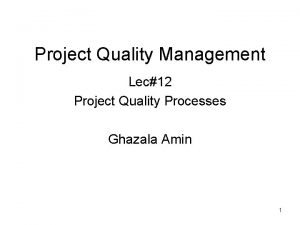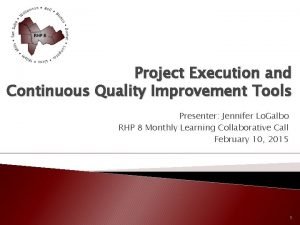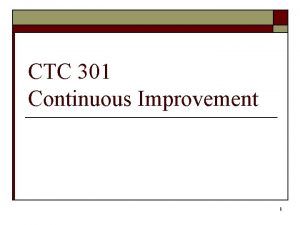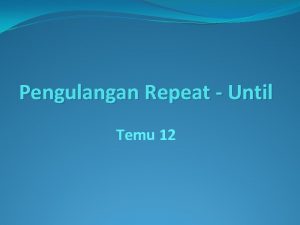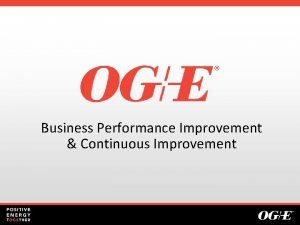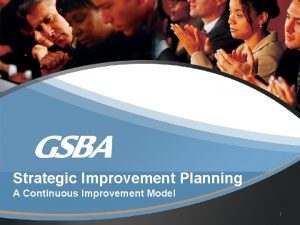Continuous Improvement Through Continuous Learning Until you are









- Slides: 9

Continuous Improvement Through Continuous Learning Until you are willing to be confused about what you already know, what you know will never become wider, bigger, or deeper. Milton Erickson, M. D.

Learning happens when: • • • Theory meets practice. Experience meets new knowledge Data confirms or negates perceptions Isolated facts emerge into patterns, trends, or new ideas. Two or more individuals’ creative potentials collide.

What is continuous improvement? • A state of mind • A belief that there is always a way to do it better • Applies to things we are doing poorly as well as what we are doing well • It means coming up with new and better ideas to produce results • It requires challenging assumptions, learning new knowledge and skills, changing attitudes and aspirations, and implementing new behaviors. • Requires thoughtful leadership

Leadership and learning are intrinsically linked in a thoughtful school

The goal of thoughtful leadership is continuously come up with new and better ideas that can be shown to produce better results Leadership in a thoughtful school looks and feels much different from leadership in traditional schools. In a thoughtful school, leadership is not about official positions of authority Rather It is about a school’s or district’s ability to engage the entire staff component in broad-based and skillful participation in learning and improvement.

A thoughtful leader: • • Engages others in the work of leadership Leads by example Acts with integrity and honor Is a learning leader committed to continuously building new knowledge for him or herself Facilitates the learning of others Makes difficult decisions on behalf of kids Is consistent, fair, and swift to act when the values of the school or community are compromised Has and adheres to a vision

The CRAFT of Leadership Collaboration: working together and taking collective responsibility with staff to achieve learning goals. Reflection: using data to inform your practice, understanding where you are now and what effects your actions have. Adaptation: applying new knowledge and skills effectively to influence the school’s learning goals. Focus: being clear about your goals for student learning and instructional improvement. Thoughtful leadership: grows as the other four elements grow. You know you have thoughtful leadership when the staff works together to develop the knowledge and skills needed to take effective action to achieve the goals and mission of the organization.

Plan, Do, Look, Learn Cycle #3 -Assess #2 -Act Do the change; take the action. #1 -Align Plan a change or revise the change Do Plan Look Learn Look at the results to learn what did and did not work. #4 -Adjust Learn from your experiences and refine the practice.

Continuous Improvement Process • Isolate the opportunity or gap between what is wanted and the current situation • Identify the student learning issues we are wrestling with. • Determine what more we need to know. How can we find out? • Establish SMART goals • Prepare graphs of student performance in areas of concern • Determine what we need to learn to help students reach your SMART goal • Correlate best practices to current practices • Identify instructional strategies we want to do more of, start doing, or stop doing to address SMART goals • Measure progress of our SMART goals • Discuss what worked well, how to hold the gains we have made, and how to revise and revisit practices that are not producing the desired results
 Insidan region jh
Insidan region jh Seligman dog experiment
Seligman dog experiment Cuadro comparativo entre e-learning b-learning y m-learning
Cuadro comparativo entre e-learning b-learning y m-learning Why don't you finish your homework
Why don't you finish your homework Till we meet at jesus feet
Till we meet at jesus feet A brick sits on a table until you push on it.
A brick sits on a table until you push on it. A brick sits on a table until you push on it.
A brick sits on a table until you push on it. Jrotc continuous improvement plan
Jrotc continuous improvement plan Continuous improvement
Continuous improvement Continuous quality improvement plan example
Continuous quality improvement plan example






